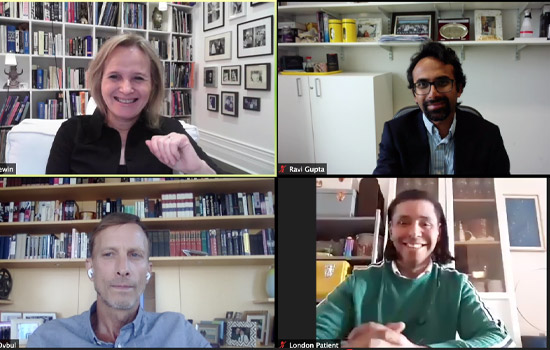
From his home, the ‘London patient’ (bottom right) talks with a group of noted HIV specialists.
The first-ever virtual edition of the world’s largest conference on HIV was held last week, AIDS 2020: Virtual. Following are a few highlights; look for more in our upcoming September+October issue.
We heard more details about the London patient, who is the second person to have achieved a functional cure following a bone marrow transplant. Also a man in Brazil appears to remain undetectable for 15 months after stopping treatment following a treatment intensification adding 2 HIV drugs on top of his current 3-drug regimen, plus nicotinamide (vitamin 3). But don’t try this at home, more tests will be needed in this patient to confirm that the virus is not hiding out and that he doesn’t have levels of HIV drug in his system. Notably, the four other people in the study did not achieve the same result, and other reports of people who achieved remission have been disappointing, with the virus eventually reappearing.
More news on long-acting injectables for treatment and prevention of HIV; while highly effective in studies and desirable by people who use them over oral regimens, a question remains as to what type of demand there will be for a shot that requires more frequent visits to a provider or clinic.
A survey of 13,562 people in 138 countries conducted from mid-April until mid-May showed that COVID-19 is having a devastating impact on the LGBTI+ community worldwide.
Researchers from a community health center in Boston that specializes in sexual health found that the COVID-19 pandemic was associated with major disruptions in PrEP care, especially among vulnerable subpopulations.
A new report on COVID-19 and HIV: IAS released a new report entitled COVID-19 and HIV: A Tale of Two Pandemics. Noting widespread service disruptions, the report looks at how COVID-19 is impacting the global HIV response and provides two sets of recommendations for policy makers, healthcare providers, researchers, scientists, healthcare workers, communities and funders.
Promising data were presented on sofosbuvir and daclatasvir as a potential treatment for COVID-19;however, the number of people was small and larger studies are needed.
Two excellent plenary sessions focused on the disparities in care and social inequities that drive the epidemic, and ways to address them.
Greg Millet, Vice President at the Foundation for AIDS Research (amfAR) and Director of amFAR's Washington DC-based Public Policy Office, said that to address disparities we need to center marginalized communities. Northwestern University professor Celeste Watkins-Hayes talked about the “injuries of inequality” and described the importance of the HIV safety net and how the HIV movement has been instrumental in moving from “dying from, to living with, to thriving despite.”
New treatments including the 2-drug regimen islatravir plus doravirine show promising results after one year, and the capsid inhibitor lenacapavir is a new long-acting injectable in Phase 1 study.

